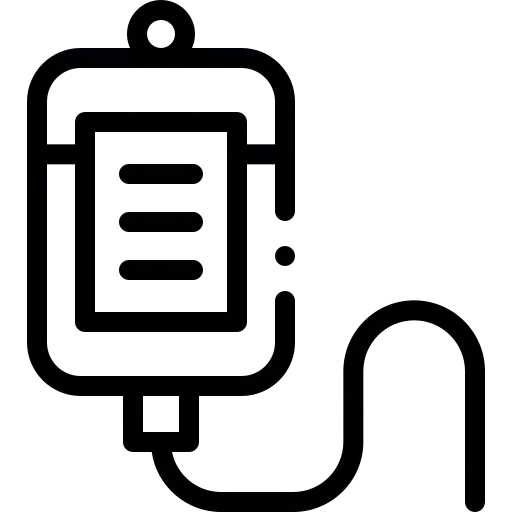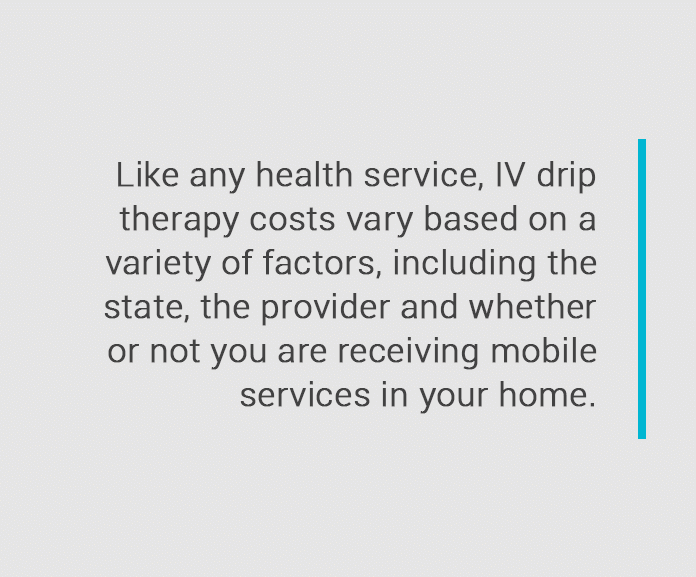[Medically Reviewed, 2023]
Written by Micaela Strevay (CNO, FNP-C), Family Practitioner
Fast, effective, budget-friendly, and painless, IV therapy has become the best solution for people struggling with nausea, dehydration, cold, and hangover, to name just a few. This complete guide covers everything you need about IV Therapy, including its benefits, side effects, cost, use cases, etc.
AZ IV Medics has prepared the visual representation of IV therapy 101. Download the infographic here.

What is IV Therapy?
IV therapy delivers fluids through a tiny needle straight to the bloodstream. These fluids have vitamins, minerals, or medications that hydrate or relieve unpleasant symptoms.
Since IV therapy bypasses the digestive system, cells can absorb nutrients much faster than they would otherwise. Because of this, many people experience symptom relief in mere minutes.
IV therapy can help reverse nutrient deficiencies and relieve symptoms related to a variety of conditions, from migraines to nausea and the cold or flu.
How does IV Therapy Work?
IV therapy works by delivering vitamins and minerals into the bloodstream through a drip. Usually, this takes place in a medical office under medical supervision. But you can also receive IV therapy in the comfort of your home via a mobile provider. The process usually takes about 30 minutes to an hour.
Here's how the IV therapy process works:

Assessment
A medical professional takes your medical history and performs a short medical exam. An IV is administered only after a thorough assessment has been conducted to determine the most appropriate treatment.

Infusion
The professional inserts a tiny needle into one of your veins and secures it. A tube connects the needle to the IV drip. The drip consists of saline, vitamins, and minerals customized to each patient's symptoms.

Monitoring
Your IV therapy and vitals are monitored to make sure the IV drip flows at the correct rate until the IV is complete.

Care
Once the IV has been administered, it is removed carefully, and pressure is applied to the site to prevent bruising.
What Happens to your Body when you Get an IV Drip?
After receiving an IV drip with vitamins, your body will feel the effects within minutes. This includes hydration, wound healing, damaged cell repair, electrolytes, joints, muscles, and bodily functions.
Additionally, various medications can be added to IV drips to relieve pain, nausea, and other unpleasant symptoms.
Common Uses of IV Therapy
Nausea
A hangover, motion sickness, or a side effect of your medication may cause nausea and vomiting, making it difficult to keep water or medicine down. As IV fluids bypass the digestive system, they can work to alleviate nausea and vomiting more rapidly.
Cold and Flu
IV therapy can help reduce the severity of cold and flu symptoms like body aches, nausea, and vomiting.
The Myers Cocktail is the best option for those with the flu or a cold. It contains multiple vitamins and minerals that support your immune system function.
Pain can be managed without narcotics with IV add-ons such as Toradol.
Welness
Since many Americans don't receive all the nutrients they need from food, they don't feel as healthy as they should. This can lead to chronic fatigue, poor sleep, low energy, and other problems.
People who receive IV therapy report improved mood, better sleep, and higher energy levels.
Dehydration
Dehydration can cause headaches, body aches, and other serious symptoms. Whether you’re dehydrated from sports-related training, illness, or hangover, IV therapy can restore hydration, boost energy, and deliver electrolytes fast.
Food Poisoning
IV therapy can reduce nausea, vomiting, and diarrhea from food poisoning. The IV delivers hydration, antacids, and anti-nausea medications directly into the body. Avoiding the stomach allows it to heal, making it more comfortable overall.
Hangovers
IV therapy after a night of drinking can hydrate your body, replenish lost nutrients, flush out toxins, and get rid of headaches and nausea quickly. You’ll begin to feel better within 30-60 minutes and won’t waste a whole day in bed.
Migraine and Headache
IV therapy for headaches can also help alleviate pain associated with migraines. Headache IV includes pain relief, hydration, and magnesium to calm tension. It only takes 30-60 minutes, and you’ll feel much better.
Morning sickness
In pregnancy, morning sickness can make it challenging to stay hydrated and get enough nutrients. IV therapy ensures you get all the vitamins and minerals you and your baby need.
It can replenish your body’s nutrients, boosting your energy. You can also add anti-nausea medication to the foods you need to stay healthy and strong.
Fatigue
IV therapy can help you feel more energetic by replenishing vital nutrients for health and wellness. These nutrients are essential for your body's optimal functioning.
What kind of Vitamins and Minerals can you Get Through an IV
IV therapy works by delivering vitamins and minerals into the bloodstream through a drip. Usually, this takes place in a medical office under medical supervision. But you can also receive IV therapy in the comfort of your home via a mobile provider. The process usually takes about 30 minutes to an hour.

Vitamin B Complex
Vitamin B complex, including vitamin B12, plays a role in multiple bodily functions like blood sugar control, metabolism, and energy production. It can help you feel refreshed and revitalized whether you're sick, hungover, or just under the weather.
B complex may also help prevent migraines or stop them faster once they've started.

Vitamin B 12
Vitamin B12 is added to most banana bags (drips), giving them a distinct yellow color.
B12 is vital for energy, weight management, and digestive health to metabolize proteins, carbohydrates, and fats in the body. Vegans, vegetarians, and those with poor nutritional intake often require this supplement.

Vitamin C
Your body needs Vitamin C to form blood vessels, muscle, cartilage, and collagen in bones. When you are deficient in vitamin C, it's easier to get sick. Vitamin C supports healthy immune system function, and it’s vital for your body's healing process.

Zinc
Your body needs Vitamin C to form blood vessels, muscle, cartilage, and collagen in bones. When you are deficient in vitamin C, it's easier to get sick. Vitamin C supports healthy immune system function, and it’s vital for your body's healing process.

Magnesium
Many enzymes rely on magnesium to work, making it essential to overall health. Increased magnesium intake can even help reduce symptoms of anxiety in deficient patients.
The functions of magnesium have positive effects for:
- Bone health
- Calcium absorption
- Diabetes
- Heart health
- Migraines

Glutathione
Glutathione is an antioxidant with several functions in the body.
This compound is essential in:
- Forming DNA
- Supporting the immune system
- Breaking down certain free radicals
- Facilitating the role of certain enzymes
- Regenerating vitamin C and vitamin E.

Taurine
Taurine is a powerhouse supplement that has many functions. It aids in regulating calcium in the body, central nervous system function, digestion, eye function, immune system function, and electrolyte balance in your cells.

Pepcid
Pepcid (famotidine) relieves coughing, stomach pain, heartburn, and difficulty swallowing. The administration of this drug via vein helps treat these conditions.

Anti Nausea Medicine
IV therapy provides your body with fluids, vitamins, minerals, and electrolytes. This can help you feel better by restoring your body and reducing your symptoms. The IV bag contains anti-nausea medicine to treat the problem directly, bypassing your stomach completely.

Anti-Pain Medicine
IV therapy provides the body with high-quality nutrition. Many organs use these nutrients to function. They can include magnesium, calcium, Vitamin C, and B vitamins. These nutrients also prevent inflammation and damage.
During IV therapy, a person receives an enhanced amount of vitamins and minerals through an intravenous line. These nutrients are delivered directly to the bloodstream without being digested. It takes less than an hour to perform the entire procedure. After the procedure, people feel no discomfort.

How Long Does IV Therapy Take and How Long Do the Effects Last?
IVs take 15-90 minutes to complete. Some patients feel the effects four days to two weeks after the IV.
An IV drip infusion usually lasts a few hours after absorption. When you are well hydrated and haven't urinated recently, you may pass some fluids more quickly than when you have urinated before the therapy.
It usually takes a couple of hours for IV Fluids to leave your body.
Any IV therapy will leave vitamins, minerals, and other nutrients in your body for days, weeks, or months, depending on your needs.
Does IV Therapy Really Work? Are there any Risks and Side-Effects?
Vitamin IV therapy can be very useful in managing unpleasant symptoms or as part of a long-term health regimen. It’s important to talk to your medical professional about whether IV therapy is right for you.
Benefits of IV Therapy for Health & Wellness
Your body may divert energy from your digestive system when you are ill. This makes it more difficult for you to absorb and process nutrients. An IV can deliver vital nutrients to your bloodstream quickly and effectively.
Vitamin IV therapy offers these additional benefits:
- Corrects vitamin deficiencies or imbalances
- A more effective way to absorb vitamins compared to oral vitamins or food
- Bypasses the digestive system for direct delivery of nutrients
- Delivers a concentrated dose of vitamins
- Optimum dosing based on body needs
- Provides a suitable alternative to oral supplements for those who cannot ingest them or have not responded to them
Drawbacks of IV Therapy
Despite vitamin IV treatments' drawbacks, most can be minimized with close supervision by a qualified healthcare professional.
Vitamin IV infusions present some challenges, including:
- Some vitamins can cause problems in high concentrations. Too much vitamin A, for example, can cause headaches, dizziness, and even death.
- tudies showing vitamin infusions' effectiveness in mainstream medicine are limited.
- IV therapy should not be used long-term or as a substitute for a healthy diet.
- Complications Electrolyte balance can be affected. Heart attacks can be caused by too much potassium, for example. can increase in mainstream treatment practices that are unregulated.
- If you have kidney or heart disease, the treatment may not be suitable since the organs cannot handle high concentrations of vitamins at one time.
In addition to these drawbacks, IV therapy can have some side effects.
Side Effects of Vitamin IV Therapy
Taking IV therapy can cause side effects for some people, so it's very important to receive treatment from a trained professional who can monitor your body's response.
Vitamin IV therapy has been associated with the following side effects:
- Infection at the injection site
- Vein inflammation and bruising
- Rashes
- Air embolism
- Blood clots
To avoid these side effects, you must inform your healthcare professional of any medications or supplements you take and any previous reactions you have had.
A reputable provider will have fewer risks, so ensure you know what to look for. Complications like infection and air embolism are more likely with unqualified providers or careless protocols.


How much does Intravenous Drip Therapy Cost?
Our prices cover the paramedic or RN coming to your preferred location and administering your IV drip, with all travel fees included.
IV drip therapy costs depend on the ingredients, your location, and the provider. Here's a quick snapshot of common IV therapies and how much they cost:
- Myer’s Cocktail - $200 - $300 (for 1000ML)
- NAD+ Drip - $100-$1,000 (for 1000ML)
- Hangover Package - $200 - $300 (for 1000ML)
- Dehydration Package - $150 - $300 (for 1000ML)
In addition to these drawbacks, IV therapy can have some side effects.
Pros and Cons of IV Therapy Over Oral Supplements
Here's a look at the top pros and cons of IV therapy.
Pros of IV Therapy
1. Complete Bioavailability
Oral supplements include tablets, and capsules, that are taken by simply swallowing, on the other hand, IV therapy vitamins completely bypass the digestive system and are absorbed directly into the bloodstream, giving you the maximum benefit.
That’s because when you eat or drink something, the vitamins and minerals in it have to go all the way through the digestive system. Not all the nutrients are absorbed, and you lose even more if your gut is not functioning well.
2. Available Customization
You can customize your IV package to suit specific needs. For example, if you only need hydration but know you're deficient in vitamin B12, you can request a B12 add-in.
3. Optimal Hydration
Up to 60% of the human body is water, yet many Americans suffer from chronic dehydration. Getting enough water isn't always easy, and if you're sweating it away frequently, it's even harder to stay hydrated, and traditional oral supplementation can’t be enough. The saline present in all IV therapy packages can allow you to experience how optimal hydration feels.
4. Immediate Benefits
One of the best features of IV therapy is that its effects set in very quickly. Many people begin to feel more energized and alert within minutes of treatment.
IV therapy has nearly immediate benefits compared to medication or drinking water. So if you need to feel better fast, you'll find no better option than IV therapy.
5. Convenience
IV therapy is fast and convenient. The process requires little effort aside from answering a few questions and holding out your arm. If you're feeling terrible due to a hangover or an illness, it's great not to work hard to feel better.
Cons of IV Therapy
1. Cost
IV therapy isn't usually covered by health insurance, so you need to pay for it.

2. Potential Reactions
Some IV therapy components may cause allergic reactions. However, an initial assessment by an RN or paramedic will include questions designed to minimize the possibility of a reaction occurring.
Because most of the ingredients in an IV drip are present in various foods, it is pretty rare for someone to have an unexpected reaction.
3. Effectiveness
IV therapy may not produce significant changes for all people. If you're dehydrated, nauseated, or otherwise feeling unwell, IV therapy effects may be more pronounced than someone who just needs a boost in energy.
Talk with your RN, paramedic, or medical professional about your symptoms and treatment goals.
Drip Bar vs. In-Home IV Therapy: Where to Get an IV?
IV drip bars are a lot like spas. They usually offer wellness services along with IV therapy. Drip bars often deliver a "healing atmosphere" and may even have a social element. In this case, drip bars are best for people who want to improve their mood and increase energy (not treat an illness).
In-home IV therapy is ideal for people who don't want to spread their illness or go out in public. It's a convenient choice that brings IV therapy to your door and administers it in your home.

What should you Look for before Planning to Undergo IV Therapy?
Here's a quick list of things to do before IV therapy to enhance your experience.
In addition to these drawbacks, IV therapy can have some side effects.
- #1. Hydrate:
Your body will be more responsive if you are hydrated before beginning the IV. That’s because the minerals and vitamins infused via IV dehydrate on the cellular level.
- It is also possible for your veins to be smaller if you are low on fluids. Drinking water before your appointment will improve your response to the IV and make veins more visible.
- #2. Relax:
Relax while you wait for your IV to start. Close your eyes and take five deep breaths in and out. Count slowly on each inhalation and exhalation to help release any nervous tension.
- #3. Eat:
Before your appointment, eat a meal/snack if you are able, and ensure it contains protein. This is because some vitamins and minerals can cause nausea if taken on an empty stomach.
- #4. Have a book or music:
Depending on your treatment plan, your IV could take up to 90 minutes to infuse. Bring your favorite magazines, books, and headphones to enjoy and relax.
- #5. Dress comfortably:
Wear a short sleeve top and comfortable pants and socks. Have a blanket nearby if you tend to get cold.
What should you Look for before Planning to Undergo IV Therapy?
What should you Look for before Planning to Undergo IV Therapy?
If you're interested in trying out IV therapy for yourself, Arizona IV Medics is here to make the process comfortable and convenient with our in-home services.
Our team of RNs and paramedics are trained to assess your needs and provide recommendations when requested, so you receive safe optimal treatment.
To learn more about our IV therapy services and schedule your appointment, call or text Arizona IV Medics at (623) 521-5034 or contact us online for a response within 24 hours.


About the Author
Micaela Strevay
(CNO, FNP-C)
Micaela Strevay is a Family Nurse Practitioner and has been apart of Arizona IV Medics since 2019. With over 10 years of healthcare experience, Micaela brings her excellent direct patient care and critical thinking to the Arizona IV Medics patients. Prior to working with Arizona IV Medics, Micaela worked in multiple level 1 trauma centers as an emergency room nurse as well as on a helicopter as a med evac nurse. Micaela graduated from Purdue University with Summa Cum Laude with her masters of science of nursing and is currently working on her doctorate of nursing with a mental health focus to better serve the Arizona IV Medics community.


